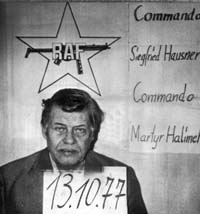Hanns Martin Schleyer
This article needs additional citations for verification. (January 2012) |
Hanns Martin Schleyer | |
|---|---|
Federation of German Industries | |
| In office 6 December 1973 – 18 October 1977 | |
| Preceded by | Hans Günter Sohl |
| Succeeded by | Nikolaus Fasolt (1978) |
| Personal details | |
| Born | 1 May 1915 Offenburg, Grand Duchy of Baden, German Empire |
| Died | 18 October 1977 (aged 62) en route to Mulhouse, France |
| Manner of death | Assassination |
| Political party | Christian Democratic Union (1970–1977) Nazi Party (1937–1945) |
| Spouse | |
| Children | 4 |
| Relatives | Johann Martin Schleyer (great-great uncle) |
| Alma mater | Heidelberg University University of Innsbruck (Dr. jur.) |
| Occupation |
|
Hans "Hanns" Martin Schleyer (German pronunciation:
He
Early life
Born in
Schleyer began studying law at the
In the summer of 1935 Schleyer accused his fraternity of lacking "national socialist spirit". He left the fraternity when the
During World War II Schleyer was drafted and spent time on the Western Front. After an accident, he was discharged and appointed president of the student body in Prague. In this position he met Bernhard Adolf, one of the German economic leaders in the Protectorate of Bohemia and Moravia, who brought Schleyer to the industrial association of Bohemia and Moravia in 1943. The association was responsible for Aryanization and the procurement of slave laborers.[7] Schleyer became an important deputy and adviser to Bernhard Adolf. On 5 May 1945, Schleyer escaped from the city shortly after the start of the Prague uprising.[citation needed]
Industrial leader in West Germany
This section needs additional citations for verification. (November 2015) |

After World War II, the Allies held Schleyer as a
His uncompromising acts during industrial protests in the 1960s such as industrial lockouts, his history with the Nazi Party, and his aggressive appearance, especially on TV (The New York Times described him as a "caricature of an ugly capitalist"[9]), made Schleyer the ideal enemy for the 1968 student movement.[10]
In 1977 Schleyer debated with Heinz Oskar Vetter, chairman of the
Kidnapping and murder

On 5 September 1977, a RAF unit "commando Siegfried Hausner", named after an RAF figure killed during the Stockholm embassy attack two years earlier, attacked the chauffeured car carrying Hanns Martin Schleyer, then president of the German employers' association, in
The RAF demanded that the German government release captured members of their organization. After this demand was declined the RAF members were all eventually found dead in their jail cells. After Schleyer's kidnappers received the news of the deaths of their imprisoned comrades, Schleyer was taken from Brussels on 18 October 1977, and shot dead en route to Mulhouse, France, where his body was left in the boot of a green Audi 100 on the rue Charles Péguy.
See also
References
- ^ Varon, Jamie (2004). Bringing the War Home: The Weather Underground, the Red Army Faction, and Revolutionary Violence in the Sixties and Seventies. University of California Press. pp. 197, 245, 252, 342.
- ISBN 978-1604861792.
- ^ Schmid, Thomas (19 October 2007). "Hanns Martin Schleyer, das unbekannte Opfer". Die Welt. Retrieved 2 May 2013.
- ^ Terror casualty Hanns Martin Schleyer, Deutsche Welle
- ^ "Bundespräsident gedenkt RAF-Opfern von Schleyer-Entführung". Archived from the original on 26 February 2023. Retrieved 10 September 2017.
- ^ "KölnSo lebte Hanns Martin Schleyer in Köln". Archived from the original on 6 September 2018. Retrieved 10 September 2017.
- ^ Kay: Dr. Hanns Martin Schleyer, S. 306.
- ^ Aus dem Tod heraus erklärt sich nichts. In: Frankfurter Allgemeine Zeitung, 24. März 2004, Nr. 71, S. L16.
- ISBN 9780307806369. Retrieved 2 May 2013.
- ^ Schleyer reference Archived 2011-07-11 at the Wayback Machine, germanguerilla.com; accessed 14 November 2015.
- ^ Frankfurter Allgemeine Zeitung, ISC-Symposium: Praktisches Management in der Villa Kunterbunt, received 2 February 2012. (in German)
External links
 Media related to Hanns Martin Schleyer at Wikimedia Commons
Media related to Hanns Martin Schleyer at Wikimedia Commons
